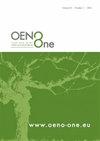Identifying the best parameters to determine genotype capability to retain adequate malic acid at harvest and in final wines
IF 2.2
3区 农林科学
Q3 FOOD SCIENCE & TECHNOLOGY
引用次数: 0
Abstract
Maintaining optimal grape acidity at harvest is one of the most complicated challenges under climate change pressures, especially in early ripening cultivars. Warming trends are compressing vine phenology and fostering berry malic acid respiration. In this work, over four years, we evaluated yield components and fruit ripening in two local varieties in the Colli Piacentini, Ortrugo (ORT) and Barbesino (BRB). Our goal was to evaluate their ability to maintain satisfying acidity at harvest and understand the limits and features of the genetic control over organic acid degradation during ripening.The two varieties exhibited comparable yield and grape total soluble solids (TSS) accumulation dynamics, but BRB showed consistently higher acidity during the entire ripening process in any of the four years. BRB's higher acidity was linked to higher malic acid concentrations. ORT had earlier onset of malic acid degradation than BRB and lower maximum malic acid degradation rates. Malic acid degradation rates were lower in ORT also later in the season, until harvest. However, correlations built between malic acid degradation rates and instantaneous malic acid concentration revealed that BRB had a consistently lower malic acid loss for values of malate < 10 g/L.Our work demonstrates that there is a genetic control over the malic acid degradation rates exhibited at varying malic acid concentrations and higher acidity at harvest can be found in varieties exhibiting low malic acid degradation rates when malic acid is < 10 g/L. Post-veraison berry growth rates could interact with genotype effects. The analysis of the correlation can be used at different scales to identify cultivars retaining higher acidity at harvest.确定最佳参数,以确定基因型的能力,以保留足够的苹果酸在收获和最终的葡萄酒
在气候变化的压力下,在收获时保持最佳的葡萄酸度是最复杂的挑战之一,尤其是在早熟品种中。变暖趋势正在压缩葡萄物候,促进浆果苹果酸呼吸。在这项工作中,我们在四年多的时间里评估了Colli Piacentini的两个本地品种Ortrugo (ORT)和Barbesino (BRB)的产量组成和果实成熟情况。我们的目标是评估它们在收获时保持令人满意的酸度的能力,并了解在成熟过程中遗传控制有机酸降解的局限性和特点。这两个品种的产量和葡萄总可溶性固形物(TSS)积累动态相当,但BRB在4年的任何一个成熟过程中都表现出较高的酸度。BRB较高的酸度与较高的苹果酸浓度有关。与BRB相比,ORT的苹果酸降解开始时间更早,苹果酸最大降解率也更低。在收获季节后期,苹果酸降解率在ORT中也较低。然而,苹果酸降解率与瞬时苹果酸浓度之间的相关性表明,当苹果酸< 10 g/L时,BRB的苹果酸损失率始终较低。我们的工作表明,在不同的苹果酸浓度下,苹果酸的降解率受到遗传控制,当苹果酸< 10 g/L时,收获时苹果酸降解率较低的品种酸度较高。变异后的浆果生长速率可能与基因型效应相互作用。相关性分析可以在不同尺度上用于鉴定收获时保留较高酸度的品种。
本文章由计算机程序翻译,如有差异,请以英文原文为准。
求助全文
约1分钟内获得全文
求助全文
来源期刊

OENO One
Agricultural and Biological Sciences-Food Science
CiteScore
4.40
自引率
13.80%
发文量
85
审稿时长
13 weeks
期刊介绍:
OENO One is a peer-reviewed journal that publishes original research, reviews, mini-reviews, short communications, perspectives and spotlights in the areas of viticulture, grapevine physiology, genomics and genetics, oenology, winemaking technology and processes, wine chemistry and quality, analytical chemistry, microbiology, sensory and consumer sciences, safety and health. OENO One belongs to the International Viticulture and Enology Society - IVES, an academic association dedicated to viticulture and enology.
 求助内容:
求助内容: 应助结果提醒方式:
应助结果提醒方式:


